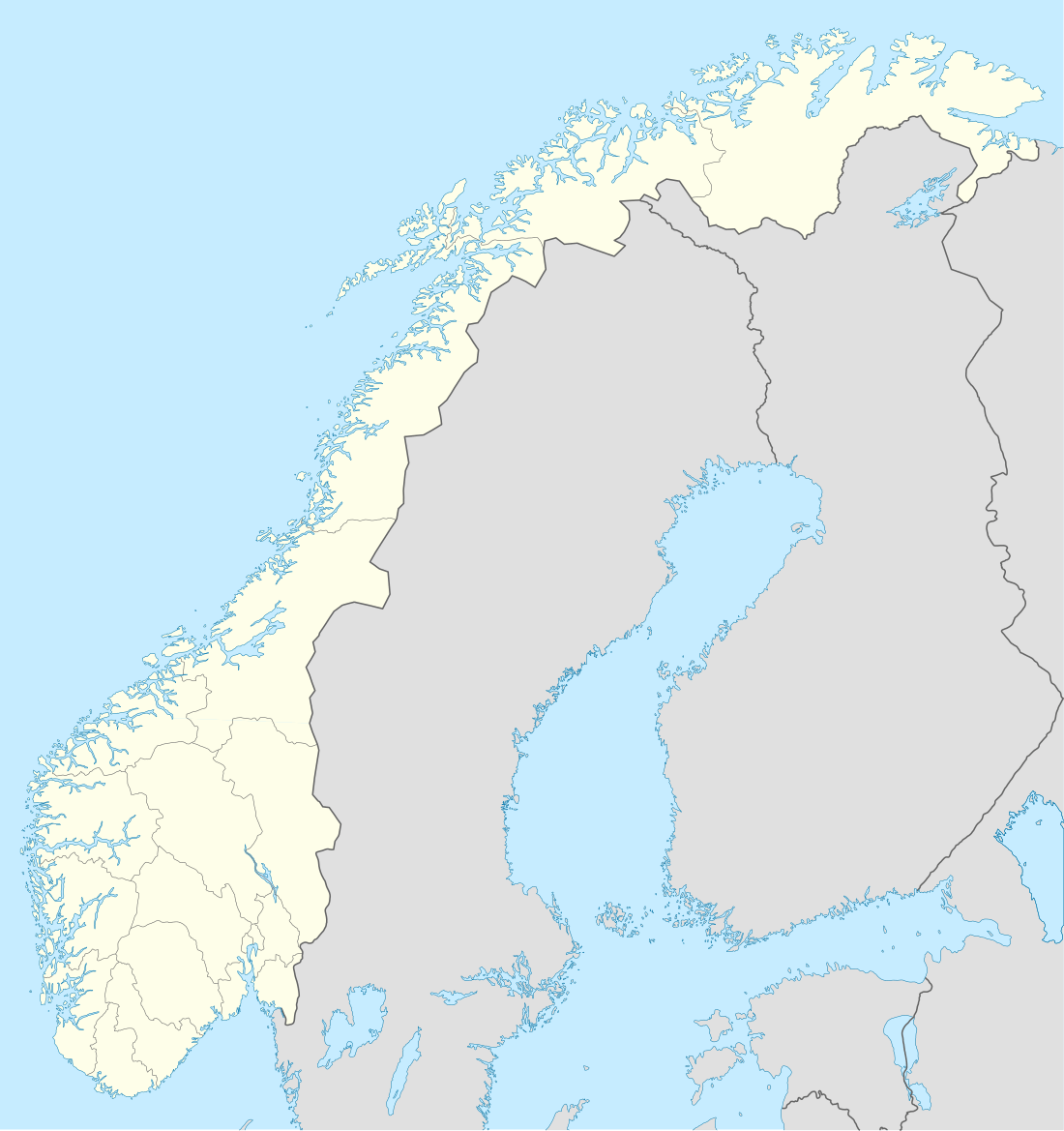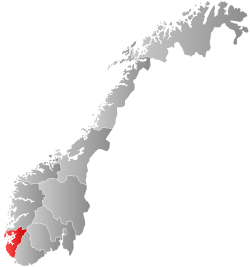Kopervik
Kopervik is the largest town on the island of Karmøy in Rogaland county, Norway. It is also the administrative centre of the municipality of Karmøy. It is part of the traditional district of Haugaland. The town was also an independent municipality from 1866 until 1965.
Kopervik | |
|---|---|
 View of the town (before 1951) | |
 Kopervik Location of the town  Kopervik Kopervik (Norway) | |
| Coordinates: 59.2801°N 5.3016°E | |
| Country | Norway |
| Region | Western Norway |
| County | Rogaland |
| District | Haugaland |
| Municipality | Karmøy Municipality |
| Established as | |
| Ladested | 1866 (until 1965) |
| By (town) | 1996 |
| Area | |
| • Total | 7.53 km2 (2.91 sq mi) |
| Elevation | 2 m (7 ft) |
| Population (2019)[1] | |
| • Total | 11,561 |
| • Density | 1,535/km2 (3,980/sq mi) |
| Demonym(s) | Koperviksbu |
| Time zone | UTC+01:00 (CET) |
| • Summer (DST) | UTC+02:00 (CEST) |
| Post Code | 4250 Kopervik
|
 Rogaland within Norway | |
 Kopervik within Rogaland | |
| Country | Norway |
| County | Rogaland |
| District | Ryfylke |
| Established | 16 Aug 1866 |
| Disestablished | 1 Jan 1964 |
| Administrative centre | Kopervik |
| Demonym(s) | Koperviksbu[3] |
| ISO 3166 code | NO-1105 |
| Preceded by | Avaldsnes in 1866 |
| Succeeded by | Karmøy in 1964 |
The 7.53-square-kilometre (1,860-acre) town has a population (2019) of 11,561 and a population density of 1,535 inhabitants per square kilometre (3,980/sq mi).[1] The municipality of Karmøy has about 42,000 inhabitants, so this means Kopervik is home to about 25% of the municipal population.
Kopervik is one of three towns in Karmøy (the others are Åkrehamn and Skudeneshavn). Kopervik is a transportation hub for scheduled boats going north to Bergen and south to Stavanger. The main industries are aluminium smelting and fishing. Kopervik contains Karmøy's municipal government buildings as well as a lot of the commercial development in the municipality. Kopervik Church has been located in the town for a long time. The previous church building was destroyed by fire in 2010, and its replacement was completed in 2016.[4]
History
The village of Kopervik was declared a ladested (town) on 16 August 1866, and since towns could not be part of a rural municipality, it was separated from the municipality of Avaldsnes to form an urban municipality of its own. Initially, Kopervik had a population of 737. On 1 January 1965, there were many big municipal mergers in Norway due to the work of the Schei Committee, and on that date the town of Kopervik was merged with the neighboring municipalities of Avaldsnes, Stangaland, Torvastad, Skudenes, and Åkra and with the nearby town of Skudeneshavn. Together these municipalities formed the new, large municipality of Karmøy. Prior to the merger, Kopervik had 1,737 residents. Kopervik lost its status as a "town" upon merging into Karmøy municipality. In 1996, due to some changes in the laws on towns, Karmøy municipality declared Kopervik to be a town once again.[5][4]
According to legend, King Sverre I of Norway ordered the construction of a wooden castle on the headland at the entrance to the harbour where Kopervik is located today. A part of Kopervik is therefore called Treborg, literally meaning "wooden castle". There is however no evidence of its existence. Kopervik was also home to Tormod Torfæus, appointed as the official Royal Norwegian historian to the Danish king during the Kingdom of Denmark-Norway.
Government
From 1866 through 1963, Kopervik was an independent municipality that was responsible for primary education (through 10th grade), outpatient health services, senior citizen services, unemployment and other social services, zoning, economic development, and municipal roads. The municipality was governed by a municipal council of elected representatives, which in turn elects a mayor.[6]
Municipal council
The municipal council (Bystyre) of Kopervik was made up of representatives that were elected to four year terms. The party breakdown of the final municipal council was as follows:
| Party Name (in Norwegian) | Number of representatives | |
|---|---|---|
| Labour Party (Arbeiderpartiet) | 9 | |
| Conservative Party (Høyre) | 5 | |
| Christian Democratic Party (Kristelig Folkeparti) | 3 | |
| Liberal Party (Venstre) | 4 | |
| Total number of members: | 21 | |
| Party Name (in Norwegian) | Number of representatives | |
|---|---|---|
| Labour Party (Arbeiderpartiet) | 9 | |
| Conservative Party (Høyre) | 5 | |
| Christian Democratic Party (Kristelig Folkeparti) | 4 | |
| Liberal Party (Venstre) | 3 | |
| Total number of members: | 21 | |
| Party Name (in Norwegian) | Number of representatives | |
|---|---|---|
| Labour Party (Arbeiderpartiet) | 9 | |
| Conservative Party (Høyre) | 4 | |
| Christian Democratic Party (Kristelig Folkeparti) | 4 | |
| Liberal Party (Venstre) | 3 | |
| Total number of members: | 20 | |
| Party Name (in Norwegian) | Number of representatives | |
|---|---|---|
| Labour Party (Arbeiderpartiet) | 7 | |
| Conservative Party (Høyre) | 4 | |
| Christian Democratic Party (Kristelig Folkeparti) | 3 | |
| Joint list of the Radical People's Party (Radikale Folkepartiet) and the Liberal Party (Venstre) | 5 | |
| Local List(s) (Lokale lister) | 1 | |
| Total number of members: | 20 | |
| Party Name (in Norwegian) | Number of representatives | |
|---|---|---|
| Labour Party (Arbeiderpartiet) | 8 | |
| Conservative Party (Høyre) | 1 | |
| Communist Party (Kommunistiske Parti) | 4 | |
| Joint list of the Radical People's Party (Radikale Folkepartiet) and the Liberal Party (Venstre) | 4 | |
| Local List(s) (Lokale lister) | 3 | |
| Total number of members: | 20 | |
| Party Name (in Norwegian) | Number of representatives | |
|---|---|---|
| Labour Party (Arbeiderpartiet) | 6 | |
| Liberal Party (Venstre) | 7 | |
| Joint list of the Conservative Party (Høyre) and the Free-minded People's Party (Frisinnede Folkeparti) | 5 | |
| Local List(s) (Lokale lister) | 2 | |
| Total number of members: | 20 | |
| Party Name (in Norwegian) | Number of representatives | |
|---|---|---|
| Labour Party (Arbeiderpartiet) | 6 | |
| Liberal Party (Venstre) | 8 | |
| Joint list of the Conservative Party (Høyre) and the Free-minded People's Party (Frisinnede Folkeparti) | 5 | |
| Local List(s) (Lokale lister) | 1 | |
| Total number of members: | 20 | |
Notable residents
- Jan Kjell Larsen, footballer
- Svein Munkejord, Former fisheries minister
- Asbjørn Sunde (1909-1985), Saboteur against the Nazi occupation of Norway
- Tormod Torfæus (1636—1719), Icelandic-Norwegian historian
- Øyvind Vaksdal, Politician
References
- Statistisk sentralbyrå (1 January 2019). "Urban settlements. Population and area, by municipality".
- "Kopervik, Karmøy (Rogaland)". yr.no. Retrieved 12 July 2020.
- "Navn på steder og personer: Innbyggjarnamn" (in Norwegian). Språkrådet.
- Store norske leksikon. "Kopervik – tidligere kommune" (in Norwegian). Retrieved 22 October 2015.
- Jukvam, Dag (1999). "Historisk oversikt over endringer i kommune- og fylkesinndelingen" (PDF) (in Norwegian). Statistisk sentralbyrå.
- Hansen, Tore, ed. (12 May 2016). "kommunestyre". Store norske leksikon (in Norwegian). Kunnskapsforlaget. Retrieved 13 July 2020.
- "Kommunevalgene og Ordførervalgene 1959" (PDF) (in Norwegian). Oslo: Statistisk sentralbyrå. 1960. Retrieved 31 July 2020.
- "Kommunevalgene og Ordførervalgene 1955" (PDF) (in Norwegian). Oslo: Statistisk sentralbyrå. 1957. Retrieved 31 July 2020.
- "Kommunevalgene og Ordførervalgene 1951" (PDF) (in Norwegian). Oslo: Statistisk sentralbyrå. 1952. Retrieved 31 July 2020.
- "Kommunevalgene og Ordførervalgene 1947" (PDF) (in Norwegian). Oslo: Statistisk sentralbyrå. 1948. Retrieved 31 July 2020.
- "Kommunevalgene og Ordførervalgene 1945" (PDF) (in Norwegian). Oslo: Statistisk sentralbyrå. 1947. Retrieved 31 July 2020.
- "Kommunevalgene og Ordførervalgene 1937" (PDF) (in Norwegian). Oslo: Statistisk sentralbyrå. 1938. Retrieved 31 July 2020.
- "Kommunevalgene og Ordførervalgene 1934" (PDF) (in Norwegian). Oslo: Statistisk sentralbyrå. 1935. Retrieved 31 July 2020.
External links
- Kopervik.info
- HistoricVideo
- Kopervik Map
- Kopervik Videregående Skole
- Kopervik Weather forecast
- Kopervik Map
- Kopervik IL (football club)
- Kopervik Volleyballklubb
- Byen Vår Kopervik
- Anne Beth Hagen Tekstilkunstner Kopervik Kulturhus

